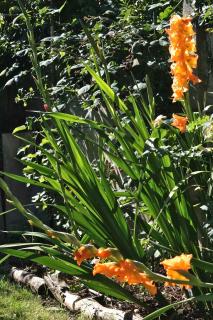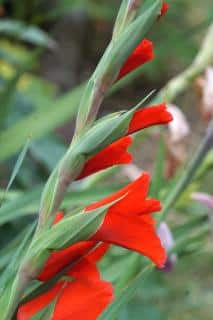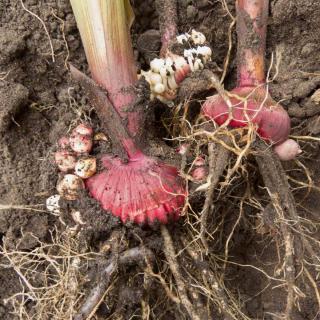

Gladiolus is among the most beautiful bulb flowers of all.
Key Gladiolus facts
Name – Gladiolus
Family – Iridaceae
Type – bulb plant
Height – 20 to 40 inches (50 to 100 cm)
Exposure: full sun – Soil: ordinary – Flowering: summer → fall
Planting and caring for gladiolus from spring to winter means to perform several small steps along its life cycle that will increase its blooming. In summer, we admire the magnificent flowers, and in winter we care for the roots and keep them from freezing…
Gladiolus is planted in spring and until the beginning of summer to a depth of 4 inches (10 cm) with a spacing of about 8 to 10 inches (20 to 25 cm) between bulbs.

If you plant your gladiolus in spots that have different levels of shade, the blooming will be in stages. Those with the heaviest shade will bloom last.
Well drained soil is a mandatory criteria when planting gladiolus.

Its flowers are particularly alluring, which makes it the star of cut flower bouquets.
Gladiolus are also very beautiful flower bed or edge plants when grouped in small clusters.
You can also grow them in rows, to produce cut flowers destined to adorn bouquets.

If the stem is cut too low, the gladiolus might not flower again in the following year.
Regular watering and adding flower fertilizer will induce spectacular and abundant flowering.

In fall, pull out the bulbs, clean them and dry them with a brush, store them in a cool, dark spot over the winter, ready for replanting in the following spring.
If your climate permits and that the weather stays mild, you can leave them in the ground all winter long. But only do this if it doesn’t freeze in your area.
Gladiolus will produce offshoots called bulblets. These are tiny bulbs that appear to the side of the mother bulb. Offshoots are genetically identical to the mother plant.

However, there comes a point where there are too many bulbs. They compete for nutrients and water. Also, you might want to plant some bulbs elsewhere or give a few away to friends and neighbors.
To do that, when you pull the bulbs out for winter, simply break the clumps of bulbs into single bulbs.
Another way to propagate gladiolus is through seeds. These appear in fall if you don’t cut flowers off. Each seed will be a mix of two parents, so you might not have the same traits as the mother flower. This is due to cross-pollination.
When preparing a bouquet, remove the top buds at the tip of the stalk because they won’t open and bloom.